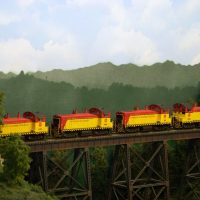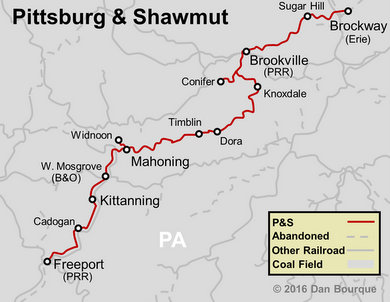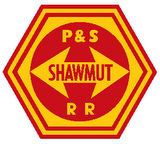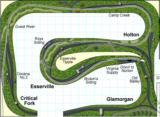| Track Plans | Photos P&S Photos Page P&S Photos Page |
Models P&S Models Page P&S Models Page |
History
 The Pittsburg & Shawmut began life in 1903 with the chartering of the Brookville & Mahoning Railroad by businessmen Frank Sullivan Smith and John Byrne. From its beginning, the Brookville & Mahoning was envisioned as a means to extend the Pittsburg, Shawmut & Northern (which had been consolidated in 1899 out of short line railroads owned by Byrne and Smith) into the rich coalfields of western Pennsylvania. Grading on the B&M began in 1905, the same year the PS&N entered receivership, a condition that would last until the PS&N was abandoned in 1947. The B&M hauled its first load of coal in 1907, and in 1909, the B&M’s name was changed to the Pittsburg & Shawmut Railroad Company. Despite the common ownership and shared motive power between the two roads, they never physically connected, instead using trackage rights over a short section of the Erie railroad in Brockwayville, PA to complete the line. Like the physical break between the P&S and PS&N, the roads were also managed by two separate teams which created tension for the existence of the relationship, and in 1916, the team controlling the P&S announced that the PS&N’s lease to operate it would be terminated making the P&S an independent road on September 1st, 1916.
The Pittsburg & Shawmut began life in 1903 with the chartering of the Brookville & Mahoning Railroad by businessmen Frank Sullivan Smith and John Byrne. From its beginning, the Brookville & Mahoning was envisioned as a means to extend the Pittsburg, Shawmut & Northern (which had been consolidated in 1899 out of short line railroads owned by Byrne and Smith) into the rich coalfields of western Pennsylvania. Grading on the B&M began in 1905, the same year the PS&N entered receivership, a condition that would last until the PS&N was abandoned in 1947. The B&M hauled its first load of coal in 1907, and in 1909, the B&M’s name was changed to the Pittsburg & Shawmut Railroad Company. Despite the common ownership and shared motive power between the two roads, they never physically connected, instead using trackage rights over a short section of the Erie railroad in Brockwayville, PA to complete the line. Like the physical break between the P&S and PS&N, the roads were also managed by two separate teams which created tension for the existence of the relationship, and in 1916, the team controlling the P&S announced that the PS&N’s lease to operate it would be terminated making the P&S an independent road on September 1st, 1916.
The mainline between Brockway, PA and Freeport, PA (near Pittsburgh) was completed in 1917. While it’s mainline passed through rolling hills and ridges, the P&S was built with many tall trestles and tunnels keeping the grades manageable for even small 2-8-0 and 2-8-2 locomotives. A few branches left the main to crawl into valleys laden with coal and tipples, but only two lasted for a significant time, the Conifer Branch and the Tidal Branch (later renamed Widnoon Branch). Tipples and loaders of varying sizes sprang up all along the mainline and branches. Coal ran both north and south and was interchanged with the Erie, Pennsylvania Railroad and B&O (former BR&P). While a few non-coal industries sprang up, the vast majority of the P&S’ business was moving coal.
The P&S dieselized in 1953 with a small fleet of EMD switchers. These SW9s would serve the road for the rest of its corporate life, augmented later by a handful of secondhand GPs. The P&S units were originally painted in a handsome maroon and yellow scheme, but after the first switcher was renumbered 1776 and repainted into a red, white, and blue bicentennial scheme, they repainted and renumbered the rest of the switchers in the same scheme adding a bright splash of patriotic color to the otherwise black and brown coal trains.
In 1990, P&S operations expanded when its parent company, ATWEC, purchased the nearby Conrail branch to the coal loader at Sligo, PA. The line was named the Red Bank Railroad but was served by P&S switchers. In 1991, Conrail sold the remaining portion of its Low Grade line to ATWEC which operated it as the Mountain Laurel Railroad. While the roads were technically separate, Mountain Laurel and P&S motive power were freely mixed on all three lines. By 1996, many of the areas coal operations had shut down, and all three railroads were sold to the Genesee & Wyoming, owner of the adjoining Buffalo & Pittsburgh. Much of the north end of the railroad was idled in 2000, and by 2007, much of the track of the P&S, along with most of the Mountain Laurel and Red Bank Railroad, had been dismantled. The Five Bridges Trail now runs over a portion of the P&S right-of-way.
Coal Lines and Operations
The P&S had two primary bases for train operations, Brookville, PA on the north end, and Kittanning, PA on the south end. Until it was discontinued, the P&S’ meager passenger operations were out of the small town of Timlin, PA. The small yard at Mahoning served as the informal dividing point between the two bases and was often served by locals out of both bases. The Brookville end of the railroad included the shops and interchanges with the Erie and Pennsy (and later the Erie Lacwanna, Penn Central and Conrail). The Brookville Local worked the mainline both north and south of town, and work mostly included placing empties and gathering loads at the many small loaders along the line and on the Conifer Branch. In the diesel era, the largest loader was at Dora which was the only loader on the line considered a unit train loader in the latter years.
Kittanning served the south end of the railroad including interchanges with the B&O (later CSX) and Pennsy. Even though the B&O passed directly over the P&S, the Kittanning Local had to traverse the two-mile West Mosgrove Branch to reach the interchange due to the elevation difference between the two roads. In addition to a handful of loaders, the Kittanning local also served a power plant at Reeseville (which only took the P&S’ small hoppers) and the Linde Air Products plant producing industrial gasses for the steel mills in Pittsburgh. After its own coal mines dried up, the large tipple and unit train loader at Cadogan was modified to serve as a coal cleaning and prep plant for other nearby mines, so raw coal was shipped in and clean coal shipped out until 1977.
The remaining diesel-era trains were the “Rounders” which included a once daily North Rounder and South Rounder that brought traffic all the way across the railroad. With a decrease in traffic and coal operations in the 1980s, the operations base at Kittanning was closed, and all trains operated out of Brookville until the P&S was sold to the Genesee & Wyoming. Even though the P&S rails were pulled up on both sides of Brookville, the shop was actually expanded by a private owner to conduct repairs and other work brought to it using the old Pennsy connection through town.
Related Products:
Sources:
Reisweber, Kurt and Brad Esposito. Pittsburg & Shawmut in Color by Morning Sun Books.
Snyder, Dennis. The Shawmut Line website.





